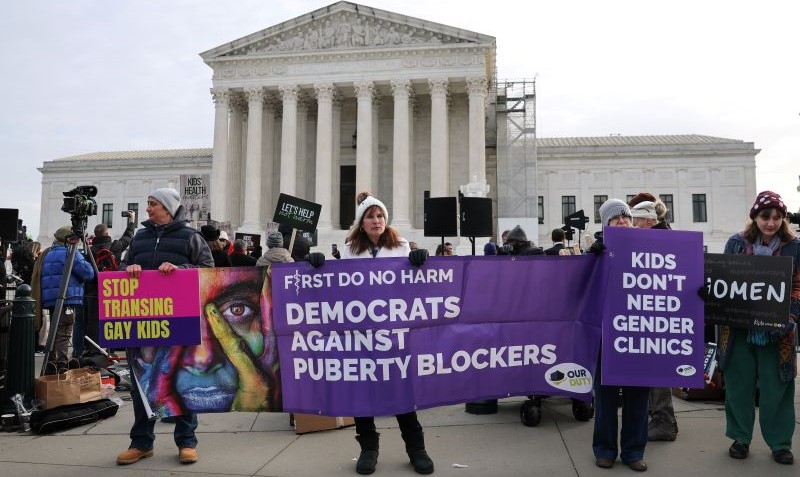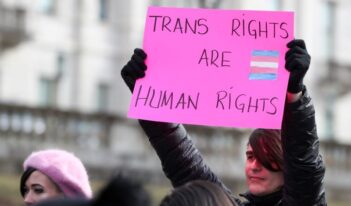
The Supreme Court runs afoul of its own equal protection doctrine by ignoring explicit classifications.
For decades, the U.S. Supreme Court has embraced an “anti-classification” approach to the Equal Protection Clause of the U.S. Constitution. Under this approach, all classifications based on certain identities—including race, sex, and national origin—are subject to a higher level of judicial review. In other words, where the government relies on certain types of classifications, courts are supposed to give the government’s actions a closer look, to make sure its aims are truly justified.
The Court has long held that this anti-classification approach is subject to no exceptions. Thus, for example, race-based classifications in the affirmative action context receive the same demanding form of judicial scrutiny that Jim Crow laws receive. In all cases, the government must have a “compelling” reason for its use of race, there must be no available race-neutral alternatives to achieve the government’s objectives, and all of this must be substantiated by the facts and evidence introduced in court.
For as long as it has existed, the Supreme Court’s anti-classification approach has drawn criticism from legal scholars, who have argued that it fails to effectively address the realities of discrimination. But I, along with other scholars, have argued that anti-classification can, at its best, serve an important function. By stepping away from divisive judgments about which forms of discrimination are harmful, this approach can help ensure that even socially contested forms of discrimination receive closer-look review.
The case of United States v. Skrmetti could have been an opportunity for the Court to embrace this more principled side of anti-classification doctrine. The Tennessee law at issue in Skrmetti deployed two salient classifications to ban gender-affirming care for transgender minors: sex and transgender status. These classifications were apparent on the face of the law: A doctor could not know whether providing care is legal without asking whether the patient was assigned male or female at birth—and the law specifically banned procedures intended to facilitate identification with, or alleviate distress associated with, “a purported identity inconsistent with the minor’s sex.” As such, a cisgender girl in Tennessee could receive even cosmetic surgery (such as breast augmentation) to enhance her female identity, while a transgender girl (assigned male at birth) could not even receive medically-necessary hormone treatments.
True, transgender rights remain deeply divisive—with critics perceiving laws such as Tennessee’s as invidious, and proponents perceiving them as important. But under anti-classification doctrine, this divide should not matter. Because the Tennessee law classified on the basis of sex and transgender status, the Court should have, under existing doctrine, given it closer-look review. After all, the Court has already held that all sex classifications receive such closer-look review. And both the present and history of discrimination against transgender people suggests that classifications based on transgender status ought to be subject to the same standard. Thus, in Skrmetti, anti-classification doctrine should have required that the state at least prove its good reasons. If gender-affirming care for trans-, but not cis-, minors is so uniquely harmful that it should be banned, then it can be—but the state must prove those harms.
But this of course is not what the Supreme Court held in Skrmetti. While repeating the state’s talking points on the harms of gender-affirming care, the Court held that no closer-look review was needed, and thus no actual evidence of harm was required. Instead, the Court found that there was no classification to begin with: no sex classification, and even more implausibly, no classification based on transgender status. As even Justice Samuel Alito, Jr., observed in concurrence—and the Court’s progressive Justices emphasized in dissent—this essentially blinks reality. It is as if the Court said that a law that prohibits people from wearing clothes “inconsistent with their sex assigned at birth” is not a sex classification—or that a policy excluding those with “black or brown skin” does not classify based on race.
If the Supreme Court’s assertion of a lack of classification in Skrmetti was so implausible, why did the Court embrace this approach? Optimistically, one might speculate that the majority took this approach because it allowed for a relatively narrow holding—one that does not predetermine other transgender rights issues. Unlike the concurrences, which would have decisively held that government efforts to target transgender people always receive only de minimis equal protection review, the majority left this issue open for another day. The majority’s reasoning also left it open to the lower courts—and the Supreme Court itself—to afford closer-look review to other sex classifications in the transgender rights context. Instead, the majority repeatedly suggested that the health care context of the law was key.
But there is also another, less optimistic perspective. We have seen in other areas of the law that this Supreme Court is willing to make major moves, while claiming it is simply holding the course. A striking example of this can be seen in the context of Bivens actions, which historically permitted individuals to sue the federal government for constitutional violations. Today, Bivens action are practically extinct. But the demise of Bivens did not come in any major decision in which the Supreme Court ruled that people can no longer sue the federal government for its constitutional wrongs—or that Bivens was wrongly decided and was therefore “overruled.” Instead, the Court has simply whittled away at the contexts in which Bivens actions are available, until practically speaking they no longer exist. Whether or not this strategy was deliberate on the part of the Court, it has been effective: It is hard to rally political opposition around each small decision nickel and diming rights, even where those decisions add up to much more.
What all of this portends for transgender rights remains to be seen. In the short term, Skrmetti leaves the courts free to continue to apply closer-look review to most transgender rights contexts—with the important exception of laws regulating gender-affirming health care. But it also offers cover for the courts, including the Supreme Court, to simply deny reality and refuse to see sex or gender identify classifications. If there was no such classification in Skrmetti, then perhaps there are also no such classifications in laws banning transgender people from the military, excluding them from sports, or banning them from gender-identity-congruent restrooms. And if there is no classification, then the state need not put on evidence of its good reasons.
Whatever our policy beliefs, we should hope this latter outcome does not come to pass. Contemporary laws targeting transgender rights deserve to be addressed on their own terms and justified—or struck down—based on real facts and evidence. Denying that they have anything to do with transgender people—or their sex—is disingenuous and dishonest. More importantly, it ignores the important work the Court has told us the Equal Protection Clause is meant to do.
This essay is part of a series, titled “The Supreme Court’s 2024-2025 Regulatory Term.”




